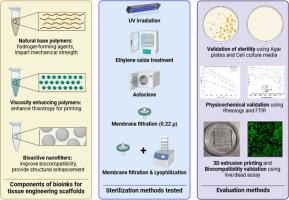灭菌生物墨水:了解技术对3D生物打印材料的影响
Q1 Computer Science
引用次数: 0
摘要
海藻酸盐、壳聚糖、明胶等天然聚合物及其衍生物被广泛应用于组织工程支架3D打印的生物墨水中。由于其天然来源和可生物降解的性质,这些聚合物极易受到微生物污染,因此有效的灭菌至关重要。本文全面分析了紫外线辐射、高压灭菌、环氧乙烷处理、膜过滤和冻干等多种灭菌方法对这些聚合物的理化性能、生物打印性能、机械强度和生物相容性的影响。此外,还进行了实验,以评估灭菌对常用的粘度增强剂(如果胶、黄原胶和瓜尔胶)、生物活性纳米填料(如蒙脱土和羟基磷灰石)和交联剂(如氯化钙、柠檬酸、戊二醛和Irgacure 2959)的影响。这些交联剂是生物墨水配方中的其他关键成分。研究结果强调,灭菌方法的选择应根据具体成分,考虑其物理化学性质,应用和实际便利性。本研究涉及对几种生物链成分的不同灭菌技术的全面检查,强调选择适当方法以确保生物链稳定性的重要性。与以前的研究不同,它提供了更广泛的评估,涵盖了广泛的常用生物链接成分,并检查了不同的灭菌方法对其稳定性的影响,从而为优化灭菌方案提供了新的见解,以增强和可复制的生物打印结果。本文章由计算机程序翻译,如有差异,请以英文原文为准。

Sterilizing bioinks: Understanding the impact of techniques on 3D bioprinting materials
Natural polymers, such as alginate, chitosan, gelatin, and their derivatives, are widely used in formulating bioinks for 3D bioprinting of tissue engineering scaffolds. Due to their natural origin and biodegradable nature, these polymers are highly susceptible to microbial contamination, making effective sterilization crucial. This research paper provides a comprehensive analysis of the effects of various sterilization methods, namely, ultraviolet radiation, autoclaving, ethylene oxide treatment, membrane filtration, and lyophilization, on the physical and chemical properties, bioprinting performance, mechanical strength, and biocompatibility of these polymers. Additionally, experiments have been conducted to assess the impact of sterilization on commonly used viscosity enhancers, such as pectin, xanthan gum, and guar gum, bioactive nanofillers like montmorillonite and hydroxyapatite, and crosslinking agents like calcium chloride, citric acid, glutaraldehyde, and Irgacure 2959, which are other critical components in bioink formulations. The findings highlight that the choice of sterilization method should be tailored to the specific component, considering their physicochemical properties, applications, and practical convenience. This study involves a comprehensive examination of different sterilization techniques for several bioink components, highlighting the importance of selecting an appropriate method to ensure bioink stability. Unlike previous research, it offers a more extensive evaluation by covering a wide range of commonly used bioink constituents and examining the impact of diverse sterilization methods on their stability, thereby offering new insights into optimizing sterilization protocols for enhanced and reproducible bioprinting outcomes.
求助全文
通过发布文献求助,成功后即可免费获取论文全文。
去求助
来源期刊

Bioprinting
Computer Science-Computer Science Applications
CiteScore
11.50
自引率
0.00%
发文量
72
审稿时长
68 days
期刊介绍:
Bioprinting is a broad-spectrum, multidisciplinary journal that covers all aspects of 3D fabrication technology involving biological tissues, organs and cells for medical and biotechnology applications. Topics covered include nanomaterials, biomaterials, scaffolds, 3D printing technology, imaging and CAD/CAM software and hardware, post-printing bioreactor maturation, cell and biological factor patterning, biofabrication, tissue engineering and other applications of 3D bioprinting technology. Bioprinting publishes research reports describing novel results with high clinical significance in all areas of 3D bioprinting research. Bioprinting issues contain a wide variety of review and analysis articles covering topics relevant to 3D bioprinting ranging from basic biological, material and technical advances to pre-clinical and clinical applications of 3D bioprinting.
 求助内容:
求助内容: 应助结果提醒方式:
应助结果提醒方式:


